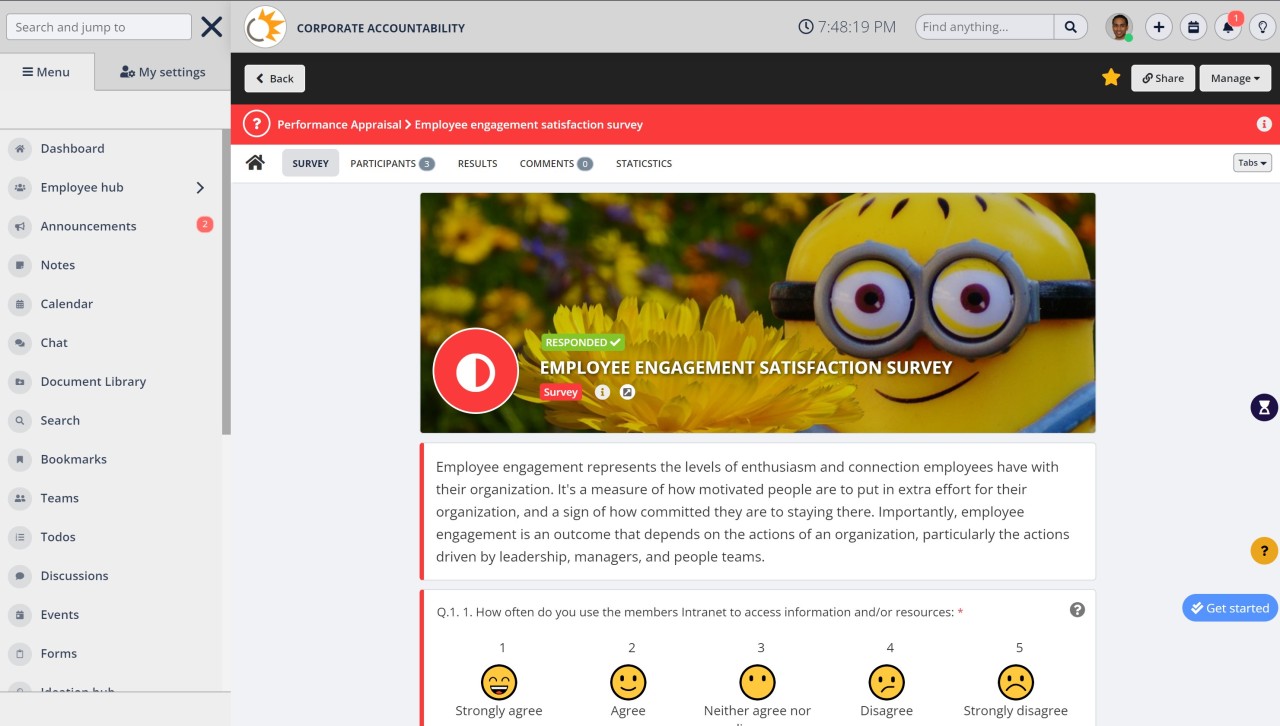Insight Blog
Agility’s perspectives on transforming the employee's experience throughout remote transformation using connected enterprise tools.
10 minutes reading time
(1980 words)
Questions to Ask for Feedback from Employees
Discover the power of questions, and the Questions to Ask for Feedback from Employees feedback through targeted questions and digital tools. Enhance engagement, job satisfaction, and productivity with actionable insights.
In today's fast-paced corporate landscape, leaders often find themselves engrossed in the pursuit of measurable outcomes—revenue growth, market share, and productivity metrics.
While these are undoubtedly critical, this results-driven focus can inadvertently overlook a vital resource for sustainable success: authentic, meaningful feedback from employees.
Recognizing the value of candid insights from your team is not just good business practice; it's the cornerstone for fostering an environment where trust, innovation, and job satisfaction thrive.
To guide you in unlocking this untapped resource, we've crafted a list of 10 indispensable questions you should be asking your employees.
These questions serve as the bridges that connect leadership intentions to employee perceptions, ultimately nurturing a culture where everyone can be their best selves.
Key Takeaways
- Employee feedback is crucial for fostering trust, innovation, and job satisfaction in today's fast-paced corporate landscape.
- Well-crafted questions can illuminate issues in work culture, procedures, and individual roles, leading to actionable insights.
- Employee feedback software streamlines real-time communication, identifies trends, and ensures anonymity for more candid responses.
- The use of employee feedback apps operationalizes insights, fostering a culture of continuous improvement and open dialogue.
- Gathering employee feedback is a strategic imperative, bridging the gap between managerial aspirations and employee perceptions for sustainable success.
10 Questions to Ask for Feedback from Employees
1. Is there any aspect of your professional environment that's hindering your progress or causing stress?
Minor issues can sometimes create major roadblocks in accomplishing tasks.
This could range from a distracting workplace setting to technical glitches. Alternatively, it might involve more complex factors like workplace culture or interpersonal dynamics. Over time, team members may decide to simply "cope" rather than seek assistance, which can erode overall team spirit.
By actively seeking feedback from your staff, you're sending the message that you're open to addressing these challenges to improve the work setting for all involved.
Follow us and access great exclusive content everyday: Follow us on Google News
2. What assistance would you like to receive?
This inquiry broadens the scope of current objectives, allowing team members to concentrate on immediate tasks while still keeping an eye on upcoming goals. Motivate your staff to establish achievable, short-term milestones that contribute to their broader, long-term development.
Find out how you can offer your support and make it a point to check in on their progress over time.
3. Which organiztional value would you want to exemplify to a greater extent?
Organizational values serve as a guiding principle for independent personnel, ensuring that development remains a primary focus.
By granting workers autonomy for their own development, they will exhibit a heightened level of commitment towards the ideals that hold the most significance to them.
You may also like: Best Apps for Employees: UPDATED 2022 – A Complete Guide
4. Do any of our procedures strike you as being particularly ineffective? What can we do to make them better?
Whether the process is straightforward or complex, giving workers the opportunity to voice their opinions on it boosts engagement and ensures that they are always thinking of ways to make things better for everyone.
When you give your workers the chance to express their opinions, you open the door to hearing potential ideas that you would not have considered otherwise.
5. What attributes do you believe are essential for enhancing the variety and depth of our team's existing culture?
Identifying someone with the right skills for the job is crucial, but bringing someone onboard who offers a fresh viewpoint can be equally valuable. The conventional approach of hiring for "cultural alignment" often involves selecting individuals who mirror existing team traits.
However, by seeking qualities that deviate from the norm—like creativity, emotional intelligence, or global experience—you'll augment both the team's diversity and its collective skill set.
Free ebook: How To Get Your Intranet Off The Ground
6. On a scale from 1 to 10, how optimistic do you feel? Could you explain why?
When your staff is optimistic about what lies ahead, this not only fosters innovative thinking but also contributes to a high-performance, low-attrition work environment.
Make it clear that experiencing difficult days is a normal part of the journey and that each person faces unique hurdles. The key takeaway is that employees should have faith in the company's future trajectory and in your leadership skills to steer them towards positive outcomes.
7. What aspect of your role do you find most fulfilling?
Drawing from various studies, it's evident that factors like independence, skill development, and a sense of purpose are major motivators.
By asking this question, you're encouraging employees to reflect on the elements of their job that provide them with a sense of fulfillment. Understanding this can be crucial for tailoring your management approach to each individual's intrinsic motivations.
8. What fuels your daily drive for achievement?
Asking this unrestricted question allows team members to share their personal definitions of success. Engage in this conversation to deepen your understanding of what each employee is aiming for.
With this knowledge in hand, you can emphasize the value of connecting with influences or experiences that can help propel them toward their career goals.
9. When do you find your job most enjoyable?
In the aftermath of challenging or high-pressure periods, this question serves as a valuable prompt for team members to recall instances when they genuinely enjoyed their work. If the response is "never," it highlights the need to prioritize relaxation and investigate any obstacles that may be inhibiting a positive workplace experience.
By understanding what elements bring joy to your employees, you can work on cultivating a work environment that not only focuses on productivity but also promotes well-being and job satisfaction.
10. Do you have a clear understanding of your role and tasks? If not, what areas are unclear?
When team members lack clarity about their specific duties or the rationale behind their tasks, it hampers their ability to be fully engaged and committed to their work. For each assignment they receive, employees should know not only what they're tasked with but also why they're doing it. Furthermore, they should be able to relate it to broader organizational and team goals.
Make it a point to revisit this discussion whenever there are shifts in roles or responsibilities to ensure everyone remains on the same page.
Good Questions to Ask Employees for Feedback about Job Satisfaction
1. Does your present employment provide opportunities for career advancement?
Throughout their professional trajectories, the majority of professionals actively seek for prospects that will facilitate their advancement inside their respective fields.
The belief that one's employment offers prospects for professional growth and advancement is of utmost importance for employees.
One may ascertain the likelihood of employee retention and choose appropriate professional development opportunities by enquiring about the extent to which employees see their current positions as conducive to achieving their career goals.
2. What is your projected duration of employment with this organization?
There are both detrimental and positive variables that may contribute to an employee's decision to terminate their job.
Understanding the desires of employees about their retention and identifying the factors that may lead to their departure are of utmost importance for organizations. Resignations stemming from external causes, such as the need for migration, are to a certain extent inevitable.
By observing occurrences of burnout and dissatisfaction among workers and implementing measures to mitigate them, management might potentially contribute to the reduction of employee turnover.
3. Do you see your viewpoint as influential to higher management?
When employees see that their contributions have a meaningful impact on the organization, they are more inclined to exhibit higher levels of commitment towards their work and demonstrate greater likelihood of maintaining long-term employment with the business.
Numerous enterprises have transitioned away from the autocratic hierarchical management approach of previous eras, opting instead for a participatory organizational structure that places significance on employee contributions.
Organizational leaders who effectively establish an environment where employees feel acknowledged and valued are more inclined to cultivate a workforce that is actively involved and committed.
4. How do You Rate Your Relationship with your Colleagues?
The amount of time that employees allocate to interacting with their colleagues may have a significant influence on their overall job satisfaction. There are several reasons that might potentially lead to workers encountering negative encounters with their colleagues.
Nonetheless, it is within the jurisdiction of management to recognize, tackle, and resolve these interactions, so averting or alleviating their incidence.
Organizations may ascertain the need of taking action to bolster their teams by soliciting feedback from employees on their perceptions of work relationships, while also providing the opportunity for anonymous responses.
5. How do you feel about the methods your management team employs to resolve conflicts?
Managers are responsible for mediating disputes between employees and between employees and their superiors. When employees face obstacles and do not believe they have the support of management, they may become disheartened.
You can determine whether employees believe they receive adequate support from management by inquiring about their supervisors' approaches to conflict resolution. If difficulties persist, you can attempt to assist.
Why Organizations Should Use Employee Feedback Software?
Organizations greatly benefit from implementing employee feedback software for several reasons.
Firstly, it streamlines the feedback process, making it easier for both employees and managers to give and receive insights in real-time. This leads to quicker problem identification and resolution, ultimately improving job satisfaction and performance.
Secondly, the anonymity feature often available in such software encourages more honest and open communication, allowing companies to address issues they may not have been aware of otherwise.
Thirdly, the software usually comes with analytics tools that help in monitoring trends, measuring engagement levels, and tracking improvements over time. By utilizing these data-driven insights, organizations can make more informed decisions, thereby creating a more efficient, engaged, and productive work environment.
Role of Employee Feedback App
The role of an employee feedback app, like from AgilityPortal, is pivotal for operationalizing the benefits of feedback in real-time.
This tool serves as the conduit for the streamlined feedback process, enabling easy collection and dissemination of input from and to all levels within the company. The app often features a user-friendly interface that encourages regular interaction, thereby fostering a culture of continuous improvement and open communication.
Its anonymity feature ensures that employees can voice concerns without fear of retribution, facilitating honest dialogues crucial for organizational growth. Furthermore, the built-in analytics tools provide an invaluable resource for HR and management, offering actionable insights that align with organizational goals.
Thus, an Employee Feedback App doesn't merely facilitate feedback; it transforms it into a strategic asset for enhancing performance, engagement, and overall job satisfaction.
Wrapping up
The act of eliciting feedback from employees is not just a managerial task; it's a strategic imperative for any organization aspiring to succeed in today's competitive landscape. A robust set of questions serves as the foundation for creating an environment where employee voices are heard and valued.
Equipped with digital tools like Employee Feedback Software and apps, organizations can harness real-time insights to make data-driven decisions. These tools bridge the gap between management aspirations and employee perceptions, ensuring a harmonious work culture that promotes trust, innovation, and, ultimately, job satisfaction.
By integrating these practices and technologies, companies are well-placed to foster an empowered workforce that contributes to sustainable success.
Categories
Blog
(2616)
Business Management
(320)
Employee Engagement
(210)
Digital Transformation
(174)
Growth
(119)
Intranets
(119)
Remote Work
(61)
Sales
(48)
Collaboration
(37)
Culture
(29)
Project management
(29)
Customer Experience
(26)
Knowledge Management
(21)
Leadership
(20)
Comparisons
(6)
News
(0)
Ready to learn more? 👍
One platform to optimize, manage and track all of your teams. Your new digital workplace is a click away. 🚀
Free for 14 days, no credit card required.















